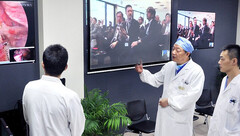
Telemedicine could enter a whole new phase thanks to advancements made possible by 5G. Doctors in China's Hainan province could successfully perform a robotic brain surgery on a patient 3,000 km away in Beijing with the help of China Mobile and Huawei's 5G network, according to local media. The low latency and high bandwidth of 5G could be extremely valuable in performing more such remote procedures in the days to come, saving a lot of time and effort for both patients and clinicians.
5G technology is poised to have a big impact on mobile communication and now, it looks like it will also play a major role in saving lives. Doctors from the Chinese PLA General Hospital (PLAGH) performed the world's first remote deep brain stimulation (DBS) implant on a patient suffering from Parkinson's disease in a hospital 3,000 km away in Beijing. The communications for the remote procedure was facilitated by China Mobile and Huawei 5G technology.
The surgery performed by Dr. Ling Zhipei lasted for about three hours. Dr. Zhipei rotates between Beijing and Hainan for work. The patient couldn't fly down to Hainan for the surgery so Dr. Zhipei resorted to telesurgery from Hainan with the patient 3,000 km away in the Beijing hospital. He said,
The 5G network has solved problems like video lag and remote control delay experienced under the 4G network, ensuring a nearly real-time operation. And you barely feel that the patient is 3,000 kilometers away."
The operation was started at 9 AM in Sanya City last Saturday (17th March) and involved manipulating surgical instruments in Beijing with micro-precision via a computer connected to a 5G network. The DBS implant was successfully placed in the optimal target site. The patient has reportedly said, "I feel good" after the procedure.
For those not in the know, Parkinson's disease is a neurodegenerative disorder that results in a progressive loss of control and coordination of voluntary movement in the body due to depletion of dopaminergic neurons in the brain. Symptoms include tremors, slow movement, stiffness in muscles, and impaired gait alongside anxiety, depression, mood swings, sleep problems, slurred speech, and constipation. The disease affects around 6.1 million individuals globally and is the subject of intense research in the field of neurology.
Although there is no cure for Parkinson's yet, the symptoms can be managed to an extent to improve the quality of life. One such method is deep brain stimulation that involves implanting electrodes in the certain areas of the brain to regulate abnormal nerve impulses. These electrodes are connected to a pacemaker that is usually placed under the skin near the collarbone.
Although this is the first remote brain surgery done on a 5G network, this is not the first time 5G technology was used in a remote operation. In January this year, doctors at the Fujian Medical University successfully performed a remote hepatic lobectomy on experimental animals placed 50 km away at the China Southeast Research Institute. The operation signal was transmitted in real time through Huawei's 5G network.
In mid-march, renowned hepatic surgeon Dr. Dong Jiahong in Beijing helped perform a complicated remote human liver surgery on a patient situated 2,000 km away in Shenzhen using 5G technology provided by China Unicom. Dr. Jiahong could guide the team in Shenzhen thanks to inputs via real-time high definition image streaming enabled by 5G.
While Huawei has facilitated these advancements in its home country, things do not seem to be on the bright side elsewhere. The United States has accused Huawei of espionage and is trying to bar Huawei from building 5G networks in the country for 'security reasons'. Canada, New Zealand, Australia, and the UK, too, aren't pleased with the Chinese telecom major.
Nevertheless, 5G technology is all set to bring a sea change in how telecommunications can help in doing traditional workflows remotely thanks to its low latency and high bandwidth.





